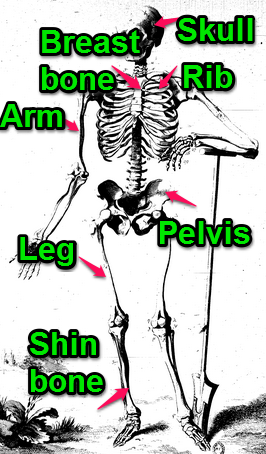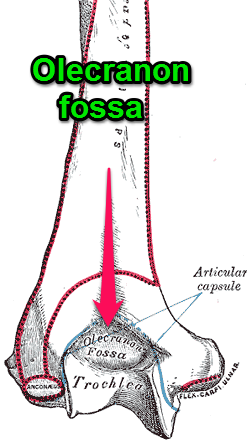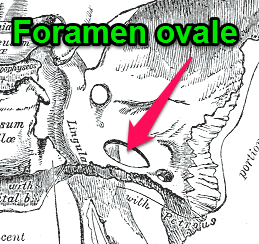Study Tips & Tools
Bone Names
When you first get the list of bones, markings, and other skeletal features you need to identify in A&P lab, the names can seem very odd. That’s because they’re based on Latin.
However, once you learn the meanings of these odd terms, you can use them as shortcuts to help you find and learn the bony structures faster and more efficiently! How? By translating the phrases, you can learn something about the specific structure, such as its location, its structure, or its function . . . and sometimes a combination of these characteristics.
|
|
Plain Latin
 Yeah, I know it would be SO much easier if bone names were in plain English. But they’re not, and no amount of whining (I’ve discovered) is going to change that.
Yeah, I know it would be SO much easier if bone names were in plain English. But they’re not, and no amount of whining (I’ve discovered) is going to change that.
But bone names are in plain “everyday” Latin. Meaning that most bone names are simple—and I mean really simple—Latin words and phrases. For example, the bone name tibia sounds weird to us but it’s simply “shin-bone” in Latin. Likewise, humerus is “arm,” sternum is “breast-bone,” and femur is simply “thigh.”
And some terms you know already, because the Latin name is also the English name. For example, you already know rib, skull, and pelvis.
The point is that it makes learning bone names far easier if you approach it as simply learning new names for things you (pretty much) already know.
Let’s look at this approach a little more closely . . .
Bone geography

If you already know the meaning of terms like river, creek, lake, ocean, hill, mountain, valley, ridge, and so on, you’ll find the going easier, right?
Likewise, there are terms used in identifying bone features—often called bone markings—that serve the same purpose. If you learn that a foramen is a hole and that a fossa is a depression, you’ll not only be able to find these structures faster, you’ll remember them for a long time.
Using the example illustrated, if you didn’t know a fossa is a depression, you wouldn’t necessarily find easily in a specimen—because on a diagram, it could look like a bump instead. And you’d be looking for a bump when you should be looking for a valley.
Before you begin learning specific names of bones and bone markings, learn the meaning of these basice “bone geography” terms. It may seem like wasted time—I know you are anxious to dive right into that long list of required structures—but it will save you time and frustration in the long run!
|
Click below for a Bone Marking Types List
|
|
|
DOCX
|
List of Bone Marking Types MS Word (.docx) version |
|
PDF
|
List of Bone Marking Types PDF (portable document file) version |
|
HTML
|
List of Bone Marking Types Interactive (web) version |
Specific bone structures

Just click on one of the links at the bottom of this page to get a list of:
- Specific skeletal structure names
- Pronunciations of structure names
- Translations of structure names
|
Click below for a Bone & Marking Names List
|
|
|
DOCX
|
Bone & Marking Names List MS Word (.docx) version |
|
PDF
|
Bone & Marking Names List PDF (portable document file) version |
|
HTML
|
Bone & Marking Names List Interactive (web) version |
Bone names are mnemonics
Although most translated skeletal names are helpful in learning about each bone and marking, they are not complete descriptions of each structure. They are, however, useful mnemonics for identifying and learning.
Mnemonic devices are learning aids that help you visualize and easily remember facts. For more on the value of mnemonics in learning anatomy—and how to use them effectively—see Mnemonics in A&P.
For example, foramen ovale (mentioned above) gives you a built-in image of an oval hole.
Some bone names, when translated, provide really vivid images for remembering them. For example, the sella turcica in the skull translates as “Turkish chair” or “Turkish saddle.” The image of a Turkish chair—a backless chair with flaired, curling arms—is what this structure actually looks like. Sort of. Or you can think of it as a saddle with a high front (pommel) and high back (cantle). Either way, it’s a built-in, vivid image to help you remember the actual structure.
The bottom line is . . . if you pay attention to structural names, it can help you learn about those structures quickly and accurately . . . and remember this information for a long time!
Check out other tips for learning human structure and function at
Last updated: October 22, 2019 at 8:15 am

